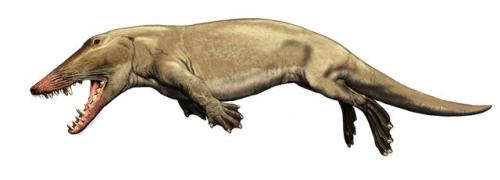dailyfossil:Ambulocetus Reconstructions by Carl Buell When: Eocene (~50 to 48 million years ago)
dailyfossil: Ambulocetus Reconstructions by Carl Buell When: Eocene (~50 to 48 million years ago) Where: Pakistan What: Ambulocetus is fossil whale relative. This beast was about 10 feet (~3 meters) long, and not very agile in either the land or the water. It was capable of movement on land, but it would have been rather slow and lumbering, as its forelimbs were shortened compared to its fully terrestrial ancestors. In the water it would have been capable of swimming with some speed, but it would not have been able to make quick turns as it chased its prey. Therefore, it has been reconstructed as an ambush-style predator, in the same niche as the modern crocodile. It would have laid in wait in the water, with its relatively dorsal eyes and nose peeking above the sufrace, able to see and smell approaching prey. Once a prey animal got close enough, Ambulocetus would launch itself from the water and try to catch the animal in its powerful jaws, such as is shown above. I think it is some form of basal horse that is trying to avoid the snapping jaws of Ambulocetus. This ambush style strategy could have also worked with aquatic prey, such as schools of fish. Ambush predation is seen in some species of whales today, Orcas (the killer whales) have been recorded ambushing seals on ice flows. Ambulocetus lived on the edge of the Tethys Sea (a body of water between India and Asia) in what is now Pakistan. At the time this region was one of many islands off the shore of the island continent of India, which had not yet collided with Asia (this would not happen for tens of millions of years). This warm seaway was full of mammals starting to return to the seas, including other lineages of whale relatives. In the cetacean family tree, Ambulocetus falls between Indohyus and modern whales; it was carnivorous - as all modern whales are-, and far more adapted for aquatic locomotion than Indohyus was, with shortened legs and a much more powerful tail. -- source link
#ambulocetus#ambulocetid


